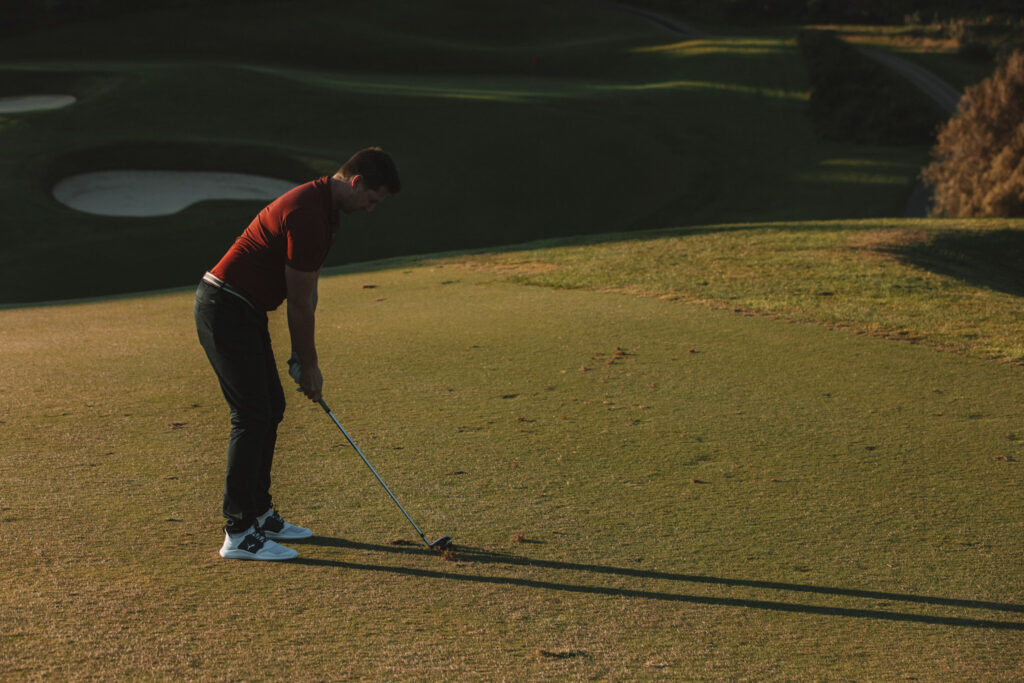How to Break 90 (or 80) in Golf: The Key Steps to Lower Scores
Every golfer dreams of breaking 90 or 80, but for many, it feels like a frustrating roadblock. One round, you’re close, then the next, a few bad holes derail everything. The good news? Lowering your scores doesn’t require a complete swing overhaul.
Success comes from smart course management, a steady mental game, and refining the areas that matter most. Driving, irons, short game, and putting. If you’re ready to make the jump, here’s a practical, no-nonsense guide to help you break through your scoring barrier.

The Mental Game: Play Smarter, Not Harder
Commit to Smarter Decisions
Golf isn’t about hitting perfect shots, it’s about avoiding big mistakes. The difference between shooting 92 and 88 often comes down to one or two bad decisions. If you’re faced with a risky shot over water, ask yourself:
✅ Is this the right play, or am I forcing it?
✅ Can I take a safer shot and still make bogey at worst?
When in doubt, play the high-percentage shot, even if it means laying up or aiming for the wider side of the fairway.
One Shot at a Time
Every golfer knows this phrase, but few actually follow it. After a bad shot, frustration kicks in, leading to rushed swings and then even more mistakes. The next time you hit a poor shot, pause, take a breath, and reset.
Golf is about recovery, not perfection. Let go of the last shot and focus only on the one in front of you.

Course Management: Position Over Power
Choose the Right Club Off the Tee
Hitting driver isn’t always the best option. If a hole has a tight fairway, consider a 3-wood, hybrid, or long iron instead. Keeping the ball in play is far more important than squeezing out an extra 15 yards.
A simple rule of thumb:
- Wide fairway? Go for the driver.
- Trouble on both sides? Take a club that guarantees you hit the short grass.
- Dogleg hole? Position the ball where you’ll have the best angle for your next shot.
Know Your Miss
Even the best players don’t hit every shot perfectly. Instead of aiming directly at the pin, play to your safe side. If you tend to miss right, aim for the left center of the green. This strategy keeps your ball in play and avoids unnecessary bogeys or worse.
Play to Your Strengths
If you’re confident with wedge shots, don’t be afraid to lay up to a comfortable distance instead of forcing a difficult long approach. Giving yourself a full shot from 100 yards is often better than trying to muscle a 5-iron onto the green from 180 yards.

Driving: Hit More Fairways with These Simple Fixes
A good drive sets the tone for the entire hole. Hitting the fairway not only gives you a better chance at hitting the green but also keeps you out of trouble, no more hacking out of thick rough or searching for lost balls. Here’s how to improve your driving consistency without overcomplicating your swing.
Focus on a Smooth Swing, Not Power
One of the most common mistakes amateur golfers make is swinging too hard in an attempt to crush the ball. The problem? More speed doesn’t always mean more distance, especially if you’re sacrificing balance and control.
Think about the last time you tried to really smash a drive. What happened? If you’re like most golfers, you probably:
❌ Lost your balance at the finish.
❌ Hit the ball off-center, leading to a weak shot.
❌ Pulled or sliced the ball into trouble.
Now, think about your smoothest, most effortless swing. Those shots often fly just as far, if not farther, because they’re hit with the centre of the clubface. That’s the key to maximizing distance: solid contact, not pure power.
Try This: The 80% Effort Rule
Instead of swinging at 100% effort, dial it back to 80%. Focus on:
✔ Maintaining balance throughout the entire swing.
✔ Making clean contact with the centre of the clubface.
✔ Finishing in a stable, controlled position.
A well-struck drive with 80% effort will travel farther and straighter than a full-blown swing that sends your ball into the trees.

Tee the Ball at the Right Height
Many golfers overlook tee height, but it plays a huge role in how well you strike the ball. Tee it too low, and you’ll hit down on it, leading to a weak, low shot. Tee it too high, and you risk catching too much of the ball’s bottom, sending a sky-high pop-up that barely makes it past the tee box.
The goal? Find the perfect balance for each club.
For the Driver
✔ Tee the ball so half of it sits above the top edge of the clubface when the driver is resting at address.
✔ This allows you to hit upward on the ball, maximizing launch angle and reducing spin for optimal distance.
✔ If you tee it too low, you’ll struggle to get the ball airborne and may hit low, weak drives.
For Fairway Woods
✔ Tee the ball slightly lower than a driver—just above the grass, so the club can sweep through cleanly.
✔ This prevents hitting the ball too high on the face, which leads to inconsistent flight and lost distance.
For Hybrids and Irons Off the Tee
✔ Tee the ball just slightly above ground level.
✔ This helps promote clean contact without interfering with your natural ball flight.
Why Tee Height Matters:
A properly teed ball ensures clean, solid contact, which leads to:
✔ Better energy transfer from the clubface to the ball.
✔ More consistent ball flight and trajectory.
✔ Fewer mishits, meaning more fairways found.

Irons: How to Hit More Greens in Regulation
Hitting more greens in regulation is one of the biggest keys to lowering your scores. When you consistently land approach shots on the green, you give yourself more chances for pars and birdies, while also avoiding the pressure of difficult chips and recovery shots.
Here’s how to improve your iron play and start hitting more greens with confidence.
Make a Controlled, Committed Swing
One of the biggest mistakes amateur golfers make with irons is trying to force distance by swinging too hard. This often leads to:
❌ Poor balance and rushed tempo.
❌ Off-center strikes that reduce distance and accuracy.
❌ A loss of control, making it harder to hit the green.
Instead, focus on a smooth, controlled swing. If you’re between clubs, always take the longer club and make an effortless swing rather than trying to muscle a shorter club.
Why?
- A longer club with a smooth swing produces better contact and a more consistent ball flight.
- A shorter club with an over-swing often results in mis-hits, ballooned shots, or weak contact.
Try This: Next time you’re unsure about club selection, take the longer club, swing at 80% effort, and focus on solid contact. You’ll be surprised at how much more controlled and consistent your shots become.
Pick a Specific Target
Aiming for the middle of the green is a good strategy, but if you want to hit more precise iron shots, you need to be even more detailed with your target selection. Instead of just thinking “Hit the green,” try focusing on a very specific landing area, such as:
✔ The back-right edge of the green if the pin is tucked in the back.
✔ The middle-left portion if there’s a bunker on the right.
✔ A shadow or discoloured patch of grass as a precise aiming point.
Why It Works
- When you focus on a small target, your brain naturally locks in on that spot, improving your accuracy.
- Aiming at a general area (e.g., “somewhere on the green”) leads to less commitment and less precise shots.
Try This: On the driving range, instead of just hitting shots toward the open field, pick specific flags, yardage markers, or small patches of grass. This builds accuracy and commitment, translating directly to better on-course results.

Stay Down Through Impact
A common mistake with irons is lifting your head too early, usually because you’re eager to see where the ball is going. The problem? This movement causes:
❌ Thin shots that don’t get enough height.
❌ Topped shots that barely get off the ground.
❌ Loss of power and consistency.
The key is to stay down through impact and focus on making a solid strike before looking up.
How to Stay Down Through Impact
✔ Feel like you’re brushing the grass with your club after the ball. This ensures a downward, ball-first strike instead of a scoop.
✔ Keep your head still and let your chest rotate naturally through the shot.
✔ Hold your finish for a second longer than usual to train your body to stay down and balanced.
✔ Feel like your bum/pelves is sticking out through impact, and not shifting towards the ball. When your pelves shifts towards the ball, your head will naturally come up.

The Short Game: The Fastest Way to Lower Scores
If you want to shoot lower scores quickly, mastering the short game is the most effective way to do it. A great drive or a crisp iron shot might feel satisfying, but it’s your chipping and putting that will determine whether you make par or bogey (or worse).
Many golfers focus too much on full swings and neglect the short shots that can save strokes. The difference between a 90s golfer and an 80s golfer often isn’t how well they hit their driver, it’s how well they get up and down around the greens.
Here’s how to sharpen your short game and start making fewer mistakes where it matters most.
Chipping: Get It Rolling Sooner
One of the biggest mistakes amateur golfers make when chipping is automatically reaching for their most lofted wedge (like a sand wedge or lob wedge). While high, soft shots look great when executed well, they’re also harder to control, especially under pressure.
Instead, a smarter and more reliable approach is to get the ball rolling as soon as possible by using a lower-lofted club like a 9-iron, 8-iron, or even a 7-iron.
Why This Works:
✔ More Consistency – A lower loft means the ball rolls like a putt instead of bouncing unpredictably.
✔ Easier to Control Distance – Rolling shots require less guesswork than high shots with unpredictable spin.
✔ Less Risk of Mishits – Chipping with a wedge increases the chance of blading the ball or chunking it.
How to Choose the Right Club for Chipping:
- If you have lots of green to work with, use an 8-iron or 9-iron and let the ball roll out like a putt.
- If you need a bit more carry before it rolls, go with a pitching wedge or gap wedge.
- Only use a sand wedge or lob wedge when you need to carry the ball over an obstacle (bunker, rough, or fringe) and stop it quickly.
Try This Drill:
On the practice green, place a tee or club halfway between your ball and the hole. The goal is to land the ball just over the tee and let it roll the rest of the way. This will teach you how much carry you need before the ball starts rolling naturally.

Putting: Speed Control is King
If you struggle with three-putts, the culprit is almost always poor speed control rather than misreading the break.
Most amateur golfers focus too much on the exact line of their putt when, in reality, getting the right speed is far more important. A putt that’s the correct speed will always have a chance to go in, even if it’s slightly off-line. But a putt that’s way too fast or too slow? That’s where three-putts happen.
How to Improve Speed Control:
✅ On Long Putts: Imagine a 3-foot circle around the hole and try to roll the ball into that safe zone. This way, even if you don’t make the first putt, your next one is a stress-free tap-in.
✅ On Short Putts (Inside 5 Feet): Commit to a firm, confident stroke rather than decelerating. A weak stroke can lead to the ball going offline or coming up short. Accelerate through the ball!
Bonus Tip: Lag Putting Drill
Before your round, spend 5 minutes hitting putts from 30+ feet with the goal of stopping them inside a three-foot circle around the hole. This builds confidence in your touch and eliminates long, stressful second putts.
How to Break 90 vs. Breaking 80
If you’re aiming to break 90, focus on:
✔ Bogey golf is okay: You don’t need birdies, just avoid big numbers.
✔ Keep tee shots in play: Even if you sacrifice distance, accuracy is key.
✔ Avoid penalties: Drop the ego and take smart shots.
To break 80, step it up by:
✔ Hitting more greens in regulation: Prioritize accuracy with your irons.
✔ Sharpening your wedge game: Save strokes by getting up and down more often.
✔ Improving your mental game: Confidence and smart decision-making separate the 80s from the 70s.

Final Thoughts: Play Smart, Stay Patient
Breaking 90 or 80 isn’t about hitting every shot perfectly, it’s about avoiding the mistakes that add unnecessary strokes. By playing smart, managing your mental game, and sharpening your short game, you’ll find yourself consistently shooting lower scores.
Next time you step onto the course, focus on strategy, commit to each shot, and trust the process, you’re closer than you think!
















